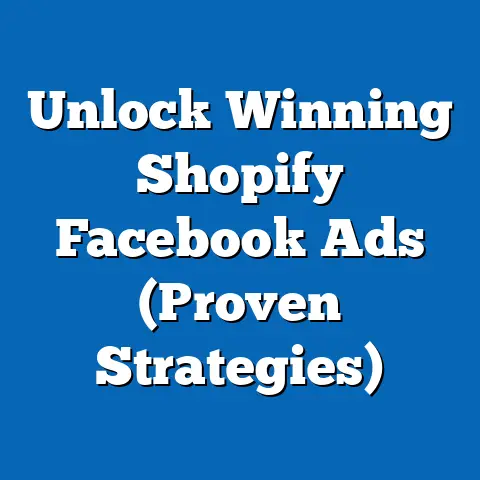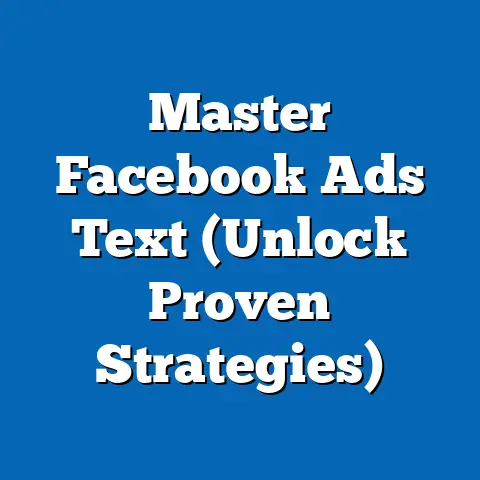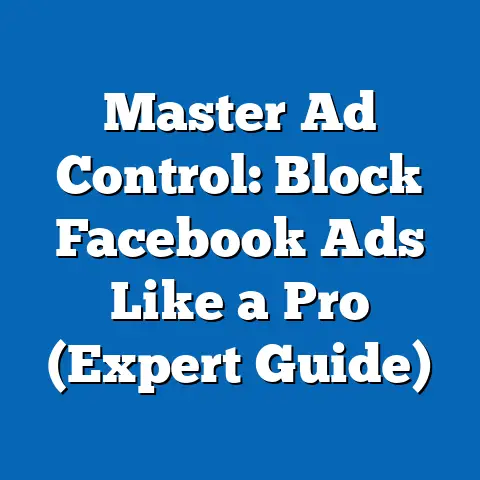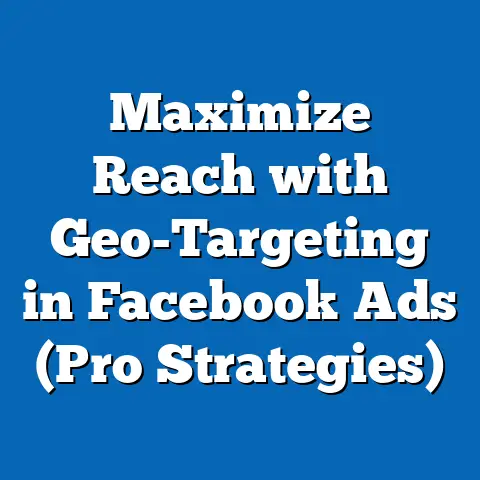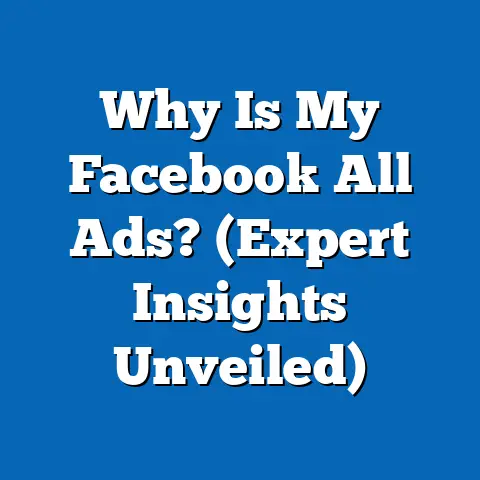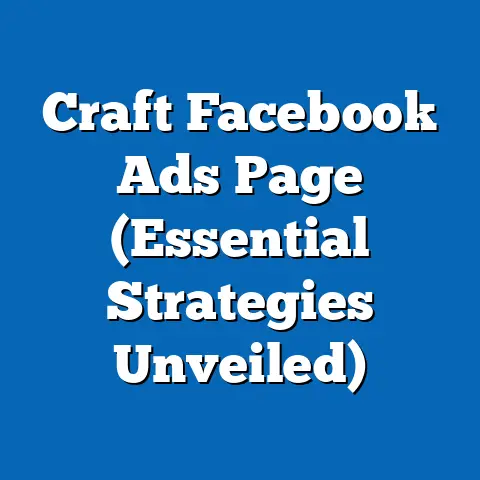Maximize ROI with Winning Facebook Conversion Ads (Pro Strategies)
Facebook advertising has become an indispensable tool for businesses aiming to thrive in today’s digital landscape. With billions of active users, the platform offers unparalleled reach and targeting capabilities. However, simply running ads isn’t enough. To truly succeed, you need to focus on Return on Investment (ROI). Maximizing ROI means ensuring that every dollar you spend on advertising generates a significant return in the form of increased sales, leads, or other desired outcomes.
In this guide, I’ll share pro strategies for creating effective Facebook conversion ads that yield high ROI. I know that the world of digital marketing can sometimes seem overwhelming, with its complex jargon and ever-changing algorithms. But don’t worry! I’ll break down these strategies into manageable steps, making them accessible to both beginners and experienced marketers. Let’s dive in and unlock the secrets to winning Facebook conversion ads.
Understanding Facebook Conversion Ads
Facebook offers a variety of ad objectives, each designed to achieve a specific goal. Conversion ads are specifically designed to drive specific actions on your website or app. Unlike awareness ads, which focus on reaching a broad audience and increasing brand visibility, or engagement ads, which aim to generate likes, comments, and shares, conversion ads are laser-focused on getting people to do something. This could be anything from making a purchase to signing up for a newsletter to downloading a whitepaper.
The primary goal of conversion ads is to generate tangible results that directly impact your bottom line. To effectively track and measure these results, you need a robust conversion tracking system in place. This is where the Facebook Pixel comes in. The Facebook Pixel is a small snippet of code that you install on your website. It allows Facebook to track the actions that people take after clicking on your ad, such as adding items to their cart, initiating checkout, or completing a purchase. By accurately tracking these conversions, you can gain valuable insights into the performance of your ads and optimize your campaigns for maximum ROI.
Takeaway: Conversion ads are all about driving specific actions. Make sure you have the Facebook Pixel set up correctly to track your results.
Crafting Compelling Ad Creative
The creative aspect of your ads – the visuals, copy, and call to action – is what initially grabs the attention of your target audience and persuades them to take action.
Visuals: Selecting eye-catching images or videos is crucial. They should be high-quality, relevant to your offer, and visually appealing to your target audience. For example, if you’re selling clothing, use professional photos that showcase your products in an attractive way. If you’re promoting a service, consider using a video that demonstrates the benefits of your offering. I’ve personally found that video ads often outperform static images, especially when they tell a compelling story or demonstrate a product in action. I once ran a campaign for a local bakery using a short video showcasing their artisan bread-making process. The video went viral, resulting in a significant increase in online orders and foot traffic to the bakery.
Copy: The ad copy should be clear, concise, and persuasive. Speak directly to your potential customers’ pain points and desires. Highlight the benefits of your product or service and explain how it can solve their problems. Use strong verbs and descriptive language to create a sense of urgency and excitement. Avoid jargon and technical terms that your audience may not understand. Instead, focus on communicating the value of your offer in a way that resonates with them. I always try to write my ad copy as if I’m having a conversation with a friend who’s facing the same challenges as my target audience. This helps me to create a more personal and relatable message.
Call to Action (CTA): A strong CTA is essential for driving conversions. It tells people exactly what you want them to do after seeing your ad. Use action-oriented language such as “Shop Now,” “Learn More,” “Sign Up Today,” or “Get Started.” Make sure your CTA is prominent and easy to find. Experiment with different CTAs to see which ones perform best. I’ve found that CTAs that create a sense of urgency or scarcity often generate the highest conversion rates. For example, “Limited Time Offer” or “While Supplies Last” can be very effective.
Takeaway: Your ad creative is your first impression. Make it count with compelling visuals, persuasive copy, and a clear call to action.
Targeting the Right Audience
Even the most compelling ad creative will fall flat if it’s shown to the wrong people. That’s why audience targeting is so critical for maximizing ROI. Facebook offers a wide range of targeting options that allow you to reach specific groups of people based on their demographics, interests, behaviors, and more.
Demographic Targeting: This allows you to target people based on their age, gender, location, education, and other demographic factors. This can be useful for reaching a broad audience with a general offer.
Interest-Based Targeting: This allows you to target people based on their interests, hobbies, and passions. This is a great way to reach people who are actively searching for products or services related to your business. I once ran a campaign for a travel agency targeting people interested in adventure travel. The campaign generated a high volume of leads and bookings because it reached people who were already passionate about the type of travel experiences the agency offered.
Behavioral Targeting: This allows you to target people based on their online behavior, such as their purchase history, website visits, and app usage. This can be useful for reaching people who are likely to be interested in your offer based on their past actions.
Custom Audiences: Custom audiences allow you to upload your own customer data, such as email addresses or phone numbers, and target those people directly on Facebook. This is a great way to re-engage existing customers or reach people who have interacted with your business in the past.
Lookalike Audiences: Lookalike audiences allow you to create new audiences that are similar to your existing customers or website visitors. This is a powerful way to expand your reach and find new customers who are likely to be interested in your offer. To create a lookalike audience, you simply upload a source audience (such as your customer list or website visitor data) and Facebook will identify people who share similar characteristics.
A/B Testing: Don’t be afraid to A/B test different audience segments to identify the most responsive groups. Create multiple ad sets, each targeting a different audience, and track their performance to see which ones generate the highest conversion rates. I once ran a campaign for a fitness studio targeting two different audience segments: people interested in weight loss and people interested in building muscle. I discovered that the weight loss audience generated significantly higher conversion rates, so I reallocated my budget to focus on that segment.
Takeaway: Targeting is key. Use Facebook’s powerful targeting options to reach the people who are most likely to convert. Don’t forget to A/B test your audiences!
Optimizing Your Budget and Bidding Strategy
Setting an effective budget and choosing the right bidding strategy are crucial for maximizing ROI. Facebook offers two main types of budgets: daily budgets and lifetime budgets.
Daily Budgets: A daily budget is the average amount you’re willing to spend each day on your ads. Facebook will try to spend this amount each day, but it may sometimes spend slightly more or less depending on the performance of your ads.
Lifetime Budgets: A lifetime budget is the total amount you’re willing to spend on your ads over the entire duration of the campaign. Facebook will try to spread your budget evenly over the campaign period, but it may spend more on certain days than others depending on the performance of your ads.
The choice between daily and lifetime budgets depends on your specific campaign goals and preferences. Daily budgets are generally better for ongoing campaigns that you want to run indefinitely, while lifetime budgets are better for campaigns with a specific start and end date.
Facebook also offers a variety of bidding strategies that allow you to control how much you’re willing to pay for each conversion. Some of the most common bidding strategies include:
Lowest Cost: This bidding strategy aims to get you the most conversions for your budget. Facebook will automatically bid on your behalf to find the lowest cost opportunities.
Cost Cap: This bidding strategy allows you to set a maximum cost per conversion. Facebook will try to get you conversions at or below your cost cap, but it may not always be able to do so.
Target Cost: This bidding strategy aims to get you conversions at a specific target cost. Facebook will adjust your bids to try to achieve your target cost, but it may not always be able to do so.
The best bidding strategy for your campaign depends on your specific goals and budget. If you’re just starting out, I recommend using the lowest cost bidding strategy to get a feel for how your ads are performing. As you gather more data, you can experiment with different bidding strategies to see which ones generate the best results.
It’s also important to monitor your ad spend and adjust your bids based on performance data. If you’re not getting enough conversions, you may need to increase your bids. If you’re spending too much money on conversions, you may need to decrease your bids. I like to set up automated rules in Facebook Ads Manager that automatically adjust my bids based on performance data. For example, I might set up a rule that automatically increases my bids if my cost per conversion is below a certain threshold, or decreases my bids if my cost per conversion is above a certain threshold.
Takeaway: Budgeting and bidding are not set-it-and-forget-it. Monitor your spend and adjust your bids based on performance.
Analyzing and Adjusting Campaign Performance
Conversion Rate: This is the percentage of people who click on your ad and then complete a desired action, such as making a purchase or signing up for a newsletter.
Cost Per Conversion: This is the amount of money you spend for each conversion.
Return on Ad Spend (ROAS): This is the amount of revenue you generate for every dollar you spend on advertising.
Click-Through Rate (CTR): The percentage of people who see your ad and click on it.
Relevance Score: Facebook’s assessment of how relevant your ad is to the audience you’re targeting. A higher score generally leads to lower costs and better performance.
Regularly analyze your Facebook Ads Manager reports to identify trends and patterns. Look for ads that are performing well and ads that are underperforming. Pause underperforming ads and reallocate your budget to high-performing ones. Experiment with different ad creative, targeting options, and bidding strategies to see what works best. I like to create a spreadsheet that tracks all of my key metrics over time. This allows me to easily identify trends and patterns and make data-driven decisions.
Takeaway: Data is your friend. Regularly analyze your campaign performance and make data-driven adjustments to improve your results.
Conclusion
Maximizing ROI with Facebook conversion ads is an ongoing process that requires careful planning, execution, and analysis. By understanding the principles of conversion ads, crafting compelling ad creative, targeting the right audience, optimizing your budget and bidding strategy, and analyzing your campaign performance, you can create winning campaigns that generate significant results for your business. Don’t be afraid to experiment, test new ideas, and learn from your mistakes. The more you practice, the better you’ll become at creating effective Facebook conversion ads that drive high ROI. Now, take action and start optimizing your campaigns today!

